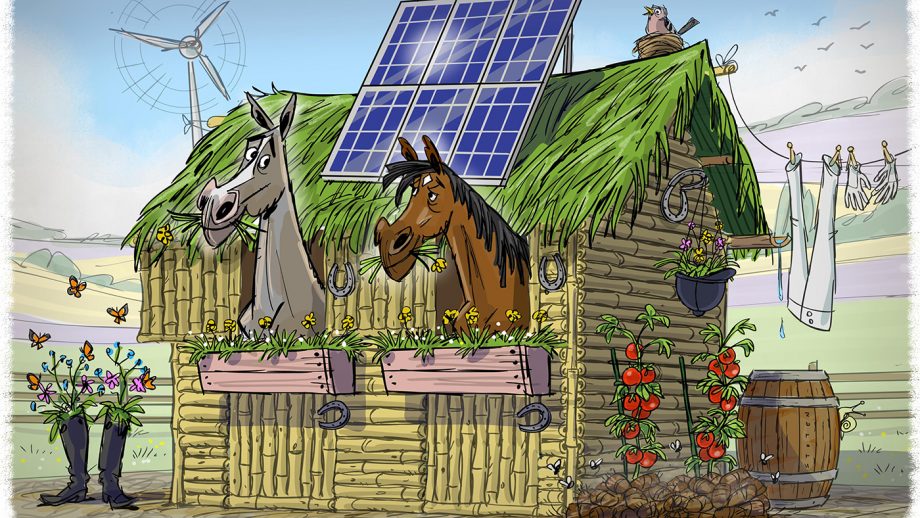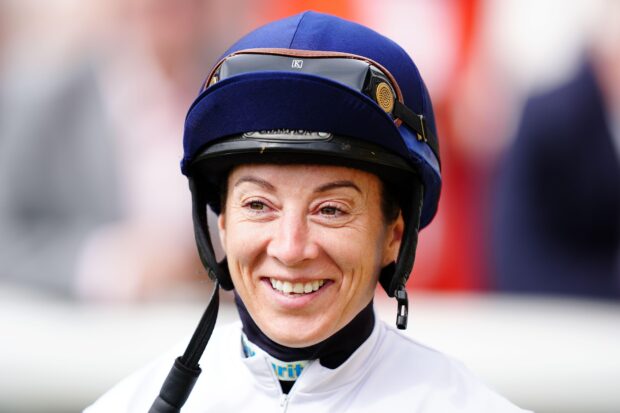Going green has huge potential to benefit and future-proof the equestrian world financially, environmentally and to attract more young people into horse sport.
The message came from Ruth Dancer, director at sustainability consultancy White Griffin, at the Horseracing Industry Conference at Newbury racecourse on 30 June.
Her messages were clear: why environmental sustainability is crucial for the equestrian world, and the planet – and how big an opportunity this is for our industry.
Mrs Dancer referred to other conversations in the industry about increasing diversity and encouraging young people, and young money, into the sport.
“This isn’t a silver bullet, but my goodness, this will help you, because the younger generation are so active in this area,” she said.
“You may say, ‘Yes, but not the horsey ones’ – yes, the horsey ones, and the ones not into horses, who you want to be into horses, coming to your racecourses, and owning and investing in racehorses.
“They are interested in the environment, and starting to be very vocal and making demands. This is a real opportunity to support your other strategies and push forward that future of horseracing.
“Come together and put together one solid communication strategy about what environmental sustainability means to you as an industry and how you’re going to appeal to those new business opportunities, staff, owners.”
In 2021 Mrs Dancer started work for the British Horseracing Authority (BHA) and the Racing Foundation, looking at environmental risks, challenges and opportunities in the industry.
Her report, published at the end of June, boiled down to six key areas, headed by the “biggy” of fossil fuels and greenhouse gas emissions, plus water availability and extreme weather, biodiversity and land use, waste and recycling, commercial partnerships and supply chain, reputation management and social responsibility.
BHA chief regulatory officer Brant Dunshea said the research gives a “much better understanding” of the challenges and provides a “useful starting point” to industry leaders.
“Racing and breeding’s close relationship with our environment makes us particularly susceptible to the effects of a changing climate,” he added.
“The findings and recommendations give us a sound basis for determining our long-term priorities and securing a sustainable future for our horses, people and businesses.”
Mrs Dancer highlighted how reliant the industry is on fossil fuels – transporting horses, jockeys clocking up 40,000 miles a year each, supporters arriving “in their throngs” by car. There is also the energy used for infrastructure, machinery and equipment, for example land management and generators.
“Doing further research into the impact of climate change and particularly correlating it to equine welfare is very important,” she said.
She urged everyone – whatever their business or role in the industry – to look at what differences they could start to make.
Water availability and extreme weather conditions are two timely issues, given the recent heatwave, that the horse world is highly aware of.
“[Water availability] is an extreme concern for this industry,” she said, stressing the need for the industry to “put this as a priority straight away.
She added that while we are “blessed” not to be in the several billion worldwide suffering from water shortage, “our time is coming in the next 10 to 20 years”.
“Kicking the problem down the road is really going to be bad news for the horseracing industry,” she said, adding that it is “a great start” that British racecourses already sign up to the leisure operator water charter, but it is a “fairly soft measure”.
“Those on the east side of the country will know that it’s officially considered an arid landscape. Racing is the third largest user of water in the leisure industry, so they’re coming for us, in the nicest possible way. They’re going to be expecting us to act and it will be in our interest to be ready and on the front foot with planning with that.”
Extreme weather and spikes in hot weather are also concerns shared by all in horse sport.
“This concept of ‘unheard of’ [weather events] is what sits in the background of climate change – that’s what it is. It’s strange phenomena happening, impacting on your operations. We need to start thinking about our mitigation and our planning for the increasing volume of extreme weather events,” she said.
“Rises in temperature, and particularly spikes and seasonable spikes of hot weather, really do impact horses.
“There are two key concerns that [equine vets] tell me; number one is transportation of horses, we know the Government is proposing restrictions on the temperatures in which you can transport horses without air conditioning, and the risk of new diseases in northern Europe.”
On the positive side, there are opportunities to make real differences, which can be beneficial to more than one part of the industry. For example, working with suppliers on recycling in a “circular economy”, which reduces landfill waste and in some circumstances, may bring down cost of production.
“You are effectively the sport of the land, you have the capability of making a profound difference at your venues and in doing so, potentially earning quite significant revenue,” she said.
“A lot of your land has potential for carbon sequestration [sucking carbon dioxide out of the air] and that could potentially open up the possibility of carbon insetting. You can put the money back into your own industry – a racecourse could pay a stud to grow and develop an appropriate amount of trees on their land to generate the necessary level of carbon offset.”
She added that this has “not been done yet, but it is possible” and there is also funding available for areas including rewilding.
“It would be a powerful message if horseracing came together under one banner, not just racing, but equestrian sports as a whole,” she said. “The role you can play in supporting and strengthening biodiversity is so much more powerful under a collective communication strategy and I urge you to do that.
“There are so many organisations who have expertise, who want to partner with you and support you.
“They don’t want money from you, they want to help you, they will build your credibility as well. Think about organisations that you benefit from. You are a valuable industry, think about who works for you, and work with them.
“A lot of amazing work has been done already. But it’s not enough and you have some real risks coming. We all want horseracing to continue and to lead the way.
“Come together as an industry and decide collaboratively what’s in the best interest of the future of your industry, your businesses and your equines.”
You might also be interested in:

Ways to create an eco-friendly stable yard
Stephanie Bateman investigates how to build or adapt stables on a low carbon footprint and why constructing a yard need

How green is your yard? 6 budget-busting eco-friendly solutions
Eco-friendly design can be incorporated into everything from light bulbs to storage solutions — and it could save you money

‘No horse, no sport – we all have a responsibility’: equestrian sport ‘in it together’ when it comes to horse welfare

Subscribe to Horse & Hound magazine today – and enjoy unlimited website access all year round
Horse & Hound magazine, out every Thursday, is packed with all the latest news and reports, as well as interviews, specials, nostalgia, vet and training advice. Find how you can enjoy the magazine delivered to your door every week, plus options to upgrade your subscription to access our online service that brings you breaking news and reports as well as other benefits.





